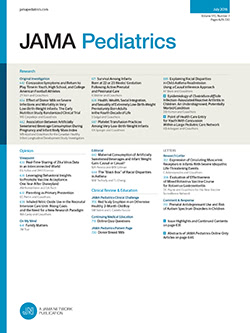Pharmacologic Management of Acute Pain in Children
IF 24.7
1区 医学
Q1 PEDIATRICS
引用次数: 0
Abstract
ImportanceSeveral pharmacologic options exist for the management of acute pediatric pain; however, their comparative effectiveness remains uncertain.ObjectiveTo assess the relative benefits and harms of pharmacotherapy for acute pediatric pain through a network meta-analysis of randomized clinical trials.Data SourcesCochrane Database of Systematic Reviews, Medline, Embase, CINAHL, Web of Science, and Scopus to October 2023.Study SelectionTrials that enrolled children (aged <18 years) with acute pain and randomized them to receive a pharmacologic analgesic vs an alternate analgesic or placebo were included.Data Extraction and SynthesisPairs of reviewers independently reviewed abstracts, extracted data, and assessed risk of bias of eligible trials. A frequentist random-effects model was used for all meta-analyses, and the certainty of evidence was assessed for treatment effects using the Grading of Recommendations Assessment, Development, and Evaluation approach.Main OutcomesThe primary outcomes were pain severity (range, 0-10 cm using a visual analog scale; minimally important difference [MID], 1 cm), need for rescue medication, symptom relief, and adverse drug events.ResultsA total of 41 trials involving 4935 children were included. High- to moderate-certainty evidence found that compared with placebo, nonsteroidal anti-inflammatory drugs (NSAIDs) (weighted mean difference [WMD], −1.29; 95% CI, −1.89 to −0.70; modeled risk difference [RD] for achieving the MID, 16%), ketamine (WMD, −1.12; 95% CI, −2.09 to −0.14; modeled RD for achieving the MID, 14%), and mid-high potency opioids (WMD, −1.19; 95% CI, −1.83 to −0.55; modeled RD for achieving the MID, 15%) reduced pain. Only NSAIDs reduced the need for rescue medication (relative risk [RR], 0.31; 95% CI, 0.14 to 0.68; modeled RD, 16% fewer patients). Neither NSAIDs (RR, 0.69; 95% CI, 0.31 to 1.55) nor acetaminophen (RR, 0.63; 95% CI, 0.21 to 1.87) increased the risk of short-term gastrointestinal adverse events. All other comparisons showed moderate-certainty evidence of little to no difference from placebo or were supported by low/very low–certainty evidence.Conclusions and RelevanceCompared with placebo, NSAIDs, ketamine, and mid- to high-potency opioids are effective in reducing acute pediatric pain. NSAIDs provide the greatest benefits and least harm, suggesting that they should be the first-line therapy for acute painful conditions in children.求助全文
约1分钟内获得全文
求助全文
来源期刊

JAMA Pediatrics
PEDIATRICS-
CiteScore
31.60
自引率
1.90%
发文量
357
期刊介绍:
JAMA Pediatrics, the oldest continuously published pediatric journal in the US since 1911, is an international peer-reviewed publication and a part of the JAMA Network. Published weekly online and in 12 issues annually, it garners over 8.4 million article views and downloads yearly. All research articles become freely accessible online after 12 months without any author fees, and through the WHO's HINARI program, the online version is accessible to institutions in developing countries.
With a focus on advancing the health of infants, children, and adolescents, JAMA Pediatrics serves as a platform for discussing crucial issues and policies in child and adolescent health care. Leveraging the latest technology, it ensures timely access to information for its readers worldwide.
 求助内容:
求助内容: 应助结果提醒方式:
应助结果提醒方式:


